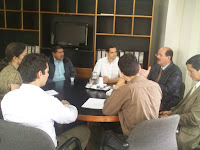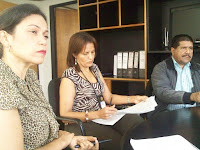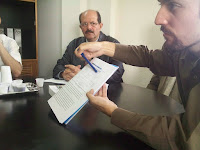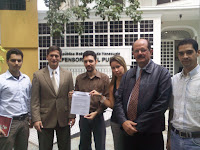Residual Chlorine Concentrations and aluminum in the water in Valencia are out Delivered On Thursday July 7, 2010, physicist Edison Durán, Mr. Manuel Pérez Rodríguez Sanitarian and Chemical Engineer Jacqueline Rodriguez, along with the Bloc. Lucio Herrera Gubaira of Anauco, in a joint press conference set position on the results so far made public Hidrocentro sampling and released the results of independent sampling, which found values \u200b\u200bof residual chlorine and aluminum in drinking water values average well above the maximum allowable Sanitary Standards for Drinking Water Quality.
Posición sobre el muestreo de Hidrocentro
Los valores publicados por los medios de comunicación de las 27 muestras analizadas por Hidrocentro y de la Comisión Estadal de Ambiente y Ordenación del Territorio pueden verse en la Gráfica 1. En el eje vertical la concentración de Cloro Residual en unidades de mg/l y en el eje horizontal el lugar y fecha de la toma de la muestra. La franja horizontal verde muestra el rango máximo permitido de Cloro Residual, el cual se encuentra establecido en el Artículo 6 de las Normas Sanitarias de Agua Potable, which specifies that the provision of potable water at any time and anywhere in the network must have a pussycat 0.3 mg / l maximum of 0.5 mg / l of residual chlorine.
Figure 1 clearly verifies that the vast majority of the samples, the residual chlorine is outside the allowed values. Specifically, 78% of the samples found outside the permitted range, with values \u200b\u200bor well above or well below. 45% of the samples have concentrations of chlorine that are up to 120% above the maximum allowable, ie are hyperchlorinated. While 33% of the samples are subcloradas and have virtually no residual chlorine. Only 6 of the samples, ie 22% had values \u200b\u200bconsistent with that established sanitary standards., While 78% of them do not.
Residual Chlorine sampling Movement for Water Quality
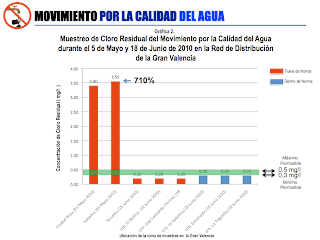
The measurements were made on 5 and 13 May and 18 June 8 points of the distribution network that geographically covers the great Valencia, whose results are shown in Figure 2. These tests were performed by 2 laboratories duly certified by the Ministry of Environment. In Figure 2 shows clearly how most of the samples have values \u200b\u200boutside the norm, with the aggravation of having extremely high values \u200b\u200bas 710% achieved during the month of May, in the La Isabelica, just as complaints about excessive chlorine content in water were almost daily. However, you can see how May and joined the values \u200b\u200bfall drastically, as measured at the same point of the city, as in the case of La Isabela, a drop of 92% over the May value. Such as abrupt changes in the concentration of chlorine residual may be due mainly to lack of continuity in the output parameters of the effluents from the plant as a result of inefficiency purification processes, and add to the evidence that we have previously shown that treatment and purification plants are not operating at optimum operating conditions and the Deputy Minister for Water, Mr. Cristóbal Francisco Ortiz, and the President of Hidrocentro, Mr. Manuel Fernandez, have stated on many occasions.
These results of the analysis both Hidrocentro as the Movement for Water Quality, demonstrate beyond doubt the chlorination of drinking water in the Great Valencia. Show that there is an excessive concentration residual chlorine in the water coming to the homes of the Valencian, and all show that the multitude of complaints from citizens about the water that cause itching, irritation of mucous membranes, skin lesions, and even respiratory problems, not a sensation , is a subjective assessment as stated by the Deputy Minister of Water and Hidrocentro officials, but a sad reality that we are suffering the Carabobo.
What other effects can have on health the chlorination of water?
As is known, provided that combine organic matter with chlorine used in the purification process, it generates some byproducts called Trihalomethanes, two of which (The Clorformo and bromoform) are considered carcinogenic when exposed to them high concentrations for long periods of time. Given these high values \u200b\u200bof residual chlorine and the huge amount of organic matter in the Pao-Cachinche Reservoir, which feeds raw water to the purification plant Alejo Zuloaga (which makes the process of chlorination) is also expected to Trihalomethanes are very high (as already demonstrated that it has been in the past) and are possibly at concentrations that pose a health risk and can create serious problems for the turn of the decade.
Concentration Sampling Aluminum Movement for Water Quality
The second parameter analyzed for their potential impact on health population was conecntración aluminum in drinking water consumed by the Carabobo. The sampling was conducted in 15 points in the low and high network covering the municipalities Valencia, Naguanagua, San Diego, Libertador and Los Guayos, on May 7, 1915 and June 18 this year, the date for which had reportedly stopped the draining of Lake Valencia and two months ago.
In Figure 3, it can be seen on the vertical axis Aluminum concentration in mg / l on the horizontal axis takes place and date of the sample. The green band indicates the maximum permissible concentration, corresponding to 0.2 mg / l as set out in Table No.1 of Drinking Water Health Standards.
Graph 3 we see that 12 of the 15 samples, ie, 87% of the samples have concentrations of aluminum than the maximum permitted values, arriving to find peaks where the concentration of aluminum in water, for example at La Isabela, , has reached values \u200b\u200bover 2600% more than those considered safe for health.
While this bill would present a statistically significant abnormality (and whose cause should explain Hidrocentro), the average of the samples excluding the maximum value gives an average concentration of aluminum of 0.75 mg / l, which is to say that in general the water that supplies the great Valencia Hidrocentro has a concentration of aluminum that exceeds 275% the maximum allowed by the Health Standards. It further appears that the same point in the Isabelica a month after the first measurement, the concentration of aluminum dramatically dropped to 0.49 mg / l, although still outside the norm by 145%.
why these values \u200b\u200bare of concern? Because Aluminum is a neurotoxic metal that when ingested in high concentré causes damage to the central nervous system, causes dementia, loss memory, apathy and severe tremors . In addition, a WHO study found that a positive correlation between the aluminum present in high concentrations, water consumption and degenerative diseases like Alzheimer's, which has been reported in several epidemiological studies, although there is no consensus in the medical community on its causation.
The intention of the Movement for Water Quality is not to cause panic or alarm the population, but if you speak out and demonstrate the reality of the problem: that there is aluminum in concentrations well above the maximum allowed in rules that supplies water to the Great Hidrocentro Valencia, so that appropriate precautions can be undertaken later, more thorough research and that this problem does not continue to grow.
is why it is important to clarify Hidrocentro demand that how is it possible that the presence of these peaks as high as 2600% higher than allowed?. How many times these high concentrations have happened in the past?. "Seguries these peaks appear in the future." "They will remain at levels similar averages almost 300% of the maximum established in the Health Norams Water Quality?
Where does this excess aluminum in the water we consume?
Alejo Zuloaga On the ground using aluminum sulphate to clarify the water, as aluminum sulfate dissolved traps particles and helps these are deposited as sediment that can be easily removed. However, in the presence of large amounts of dissolved organic material, as actualemnte with water from the Pao-Cachinche Emlbalse, process loses efficiency and aluminum sulfate dissolved passes distribution network, thus reaching our homes. This shows once again that the treatment plants and water treatment are not operating efficiently, where there are flaws in the processes of flocculation, filtration and chlorination.
nothing With these encouraging results, we continue to ask why hidrocentro refuses to publish the values \u200b\u200bthat show water quality over the past 10 years and above, because they have refused to publish values \u200b\u200bduring the two years while it has been working through?, teimpo during which which has been public knowledge deteriorating water quality.
Implications of Aluminum in the water for health
Due to the high concentrations of aluminum in the water we drink, and most stocks a dozen of proven cases of children living in the Gran Valencia have high concentrations of aluminum, has been held responsible to appeal to parents if they see their children have certain symptoms that do not go according to development cognitive, speech problems, motor impairment, loss of staring, isolation (among others), is appropriate to rule out contamination by metals, which can be in urine, blood, and through a mineralograma of hair, which is the recommended diagnostic study is the most complete.
needed is clear that metal poisoning, particularly aluminum, can come from various sources and not just water, but it is also true that there has been an increase in cases of false diagnoses within the autism spectrum in Carabobo State, from poisoning metals, aluminum being the most common in mineralogramas to hair, which has been certified by Dr. Lorena Benarroch, Carabobo being the second state in the country with more cases reported, especially in the last 3 years. That is why it is of vital importance for the participation of agencies and institutions related to health, to conduct epidemiological studies to quantify the potential impact on health in the Carabobo of these high concentrations of chlorine in the water.
Proposed Solutions
also gave released an initial set of proposals that if implemented, would help reduce the problem of water in Carabobo. Among them are:
1) Cesar definitely and remove the pump system of Lake Valencia to Cachinche Pao. The water of Lake Valencia is not fit to be drinkable. The Environment Min must find another outlet for the surplus of the lake. This water does not even meet the quality required by the Environment by Dec. 3219 min. How is it possible that you are polluting Cachinche ruthlessly? The alleged natural purification that can occur within 40 km of journey should be measured over time as to derive representative of valid conclusions. The water treatment plants are not designed to eliminate all forms of pollution, especially when it comes to toxic elements and compounds dissolved in water.
2) TREATMENT Pao Cachinche: The Cachinche Pao reservoir should not be extending the current ventilation system. Aeration is being used at this time creates a turbulent flow upward resuspended phosphorus and nitrogen are in the background which is the fuel for the algae to grow. Instead we recommend the installation of equipment specially designed to set in motion horizontal circulation of water bodies located in the epilimnion, can promote the dissolution of atmospheric oxygen in the water,
3 ) Apply best practices of modern management in the operation and maintenance both treatment plants and wastewater treatment plants in La Mariposa, The Guayos and Taiguaiguay. Is a clear lack of management attention to operation and maintenance of these treatment plants that do not fully meet the secondary aeration processes and stabilization of sludge, or given importance to the deplorable state of neglect of these crucial facilities.
4) law on the use of agrochemicals in agriculture and manufacturing and marketing in the country of detergents biodegradable.
5) Restore natural wetland status was intentionally removed in 2000 and was known as the Paito or Laguna desparramadero El Paito. The desparramedero of the pait was shared by the Rio Cabriales and Caño La Yuca and there stirred a lot of organic pollution that now reaches Cachinche Pao.
6) Convert landfills open pit located in the Valencia Lake Basin - Pao, in processing plants as a source of contamination of groundwater and surface water courses in their respective municipalities. It is important to repeat that water treatment plants are not designed to eliminate all forms of pollution, especially when it comes to toxic elements and compounds dissolved in water.
7) Activate Hydrographic Region Council referred to in the Water Law published, and develop Comprehensive Management Plan of the Waters of Lake Valencia Basin and Rio Pao.
 After a very long time of procrastination and delay, the Regional Committee for Environment, Natural Resources and Planning of Carabobo State, presented to the public, on 08 October its report for the sample obtained during the month of June this year. Same analysis included:
After a very long time of procrastination and delay, the Regional Committee for Environment, Natural Resources and Planning of Carabobo State, presented to the public, on 08 October its report for the sample obtained during the month of June this year. Same analysis included: 







